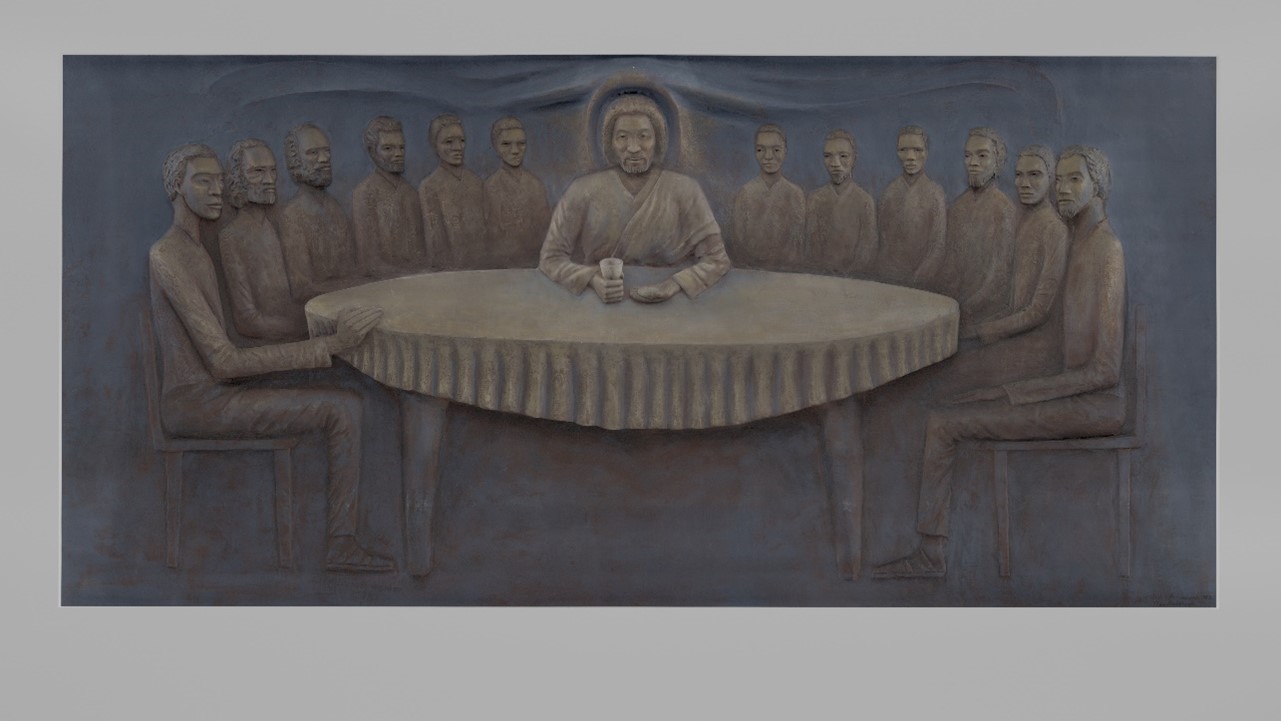Last Supper Sculpture Now Available in 3D

Rendering of a 3D model of “The Last Supper” sculpture by Akili Ron Anderson, 1982; digitally recreated 2021.
Credit: Collection of the Smithsonian’s National Museum of African American History and Culture, original artwork Copyright Akili Ron Anderson.
The Smithsonian’s National Museum of African American History and Culture recently digitized a 20-foot sculpture by artist Akili Ron Anderson, now available online nmaahc.si.edu/lastsupper. The sculpture, created by Anderson in 1982, was rediscovered in 2019 behind a temporary drywall at the former New Home Baptist Church, now the Studio Acting Conservatory, in Washington, D.C. The 3D model is part of the online exhibition “Jesus’ Hair Like Wool,” which explores contemporary and historical depictions of Black Messiahs within American religion and popular culture. The Smithsonian 3D team in the Digitization Program Office created an augmented reality (AR) of the sculpture so that viewers can superimpose it on their wall at home, working directly from the web browser, with no apps or downloads required.
“This searing scene of the Last Supper by sculptor Akili Ron Anderson allows a unique entry into the mystery of the Resurrection by showing the Messiah and his disciples as people of African descent,” said Kevin Young, the Andrew W. Mellon Director of NMAAHC. “Calming and awe-inspiring in tone, it invites Black viewers to contemplate what it means to be created in God’s image.”
Over the past century, other African American artists have depicted Jesus and his disciples as persons of African descent. In 1968, first-generation Lebanese Roman Catholic priest Father Raymond Ellis commissioned artist Devon Cunningham to create a fresco of the Last Supper to represent the changing demographic of St. Cecilia Church, now St. Charles Lwanga Parish, in Detroit. Ellis stated when asked about the choice to commission a Black Christ, “We paint Christ as a Black man to express our faith that he lives in the black man and the black man lives in him.”
The 1969 March issue of Ebony magazine included a cover image of a Black Christ figure. The cover gained national prominence and prompted public hate for the magazine’s “The Quest for a Black Christ” story by asking readers, “Was Jesus of Nazareth a Black man?”
The conservation, 3D scanning and exhibition project was undertaken by the Center for the Study of African American Religious Life and funded by Lilly Endowment Inc.
About Akili Ron Anderson’s Approach
“I think it’s important for Black children sitting in churches all over this country on Sunday morning to look up at the windows, look up at images and see themselves and believe that they can ascend to heaven, too,” Anderson said.
AfriCOBRA (a collective of Black artists) artist Anderson used men, women and children from the New Home Baptist Church congregation as inspiration for the disciples’ faces, creating a work of art that invites everyone to the table. The sculpture is an aesthetic testimony to the importance of seeing oneself in one’s environment.
About Augmented Reality
AR technology allows users to experience virtual objects in real-world spaces as viewed through a cellphone or other mobile device. The screen displays the environment through its camera and superimposes the virtual object on top. As the user moves around the object, it stays in place as if it were there with the viewer.
About the Museum
Since opening Sept. 24, 2016, the National Museum of African American History and Culture has welcomed 10 million in-person visitors and millions more through its digital presence. Occupying a prominent location next to the Washington Monument on the National Mall in Washington, D.C., the nearly 400,000-square-foot museum is the nation’s largest and most comprehensive cultural destination devoted exclusively to exploring, documenting and showcasing the African American story and its impact on American and world history. The museum has also launched and is continually expanding its reach with the Searchable Museum portal and other efforts to bring African American history into the world’s hands and homes. For more information about the museum, visit nmaahc.si.edu, follow @NMAAHC on Twitter, Facebook and Instagram or call Smithsonian information at (202) 633-1000.
# # #
SI-96-2024
Melissa Wood
202-297-6161
